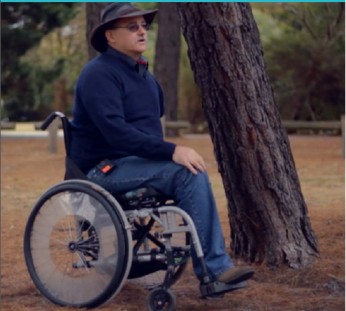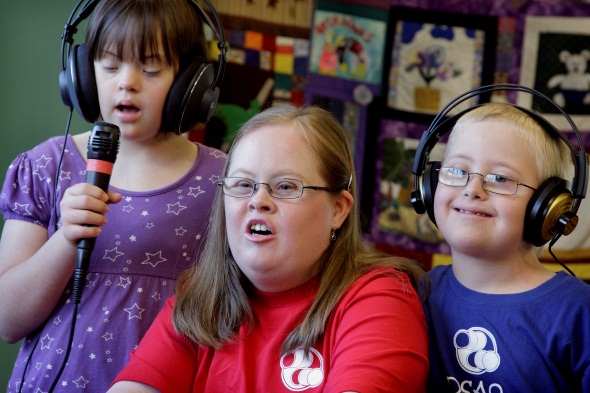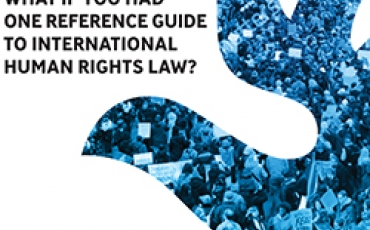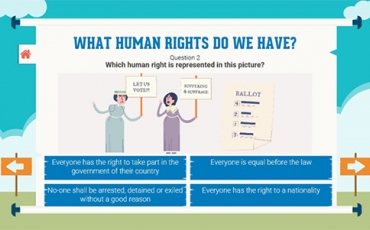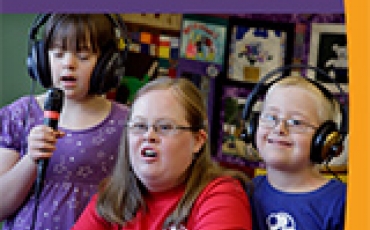RightsEd: Disability Rights: Accessibility and Liveability
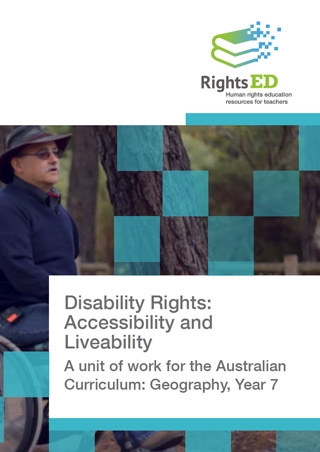
Contents
- Introduction
- Focus
- Teaching and Learning Activities
- Learning Outcomes
- Australian Curriculum Links – Geography
- Disability Rights: Accessibility and Liveability
Lessons
- Lesson 1: What makes a community liveable for diverse groups of people?
- Lesson 2: Assessing the liveability of your local suburb
- Lesson 3: Disability rights and accessibility
- Lesson 4: Assessing and improving the liveability of your school environment for people with disabilities
- Lesson 5: Examine the importance of accessible transport
Resources
- RightsED Activity Sheet: Picture Difference
- RightsED Activity Sheet: Defining Liveability
- RightsED Activity Sheet: What makes a community liveable for different groups of people?
- RightsED Resource Sheet: Hypothetical discrimination scenarios
- RightsED Resource Sheet: Disability Discrimination Act and Access to Premises
- RightsED Activity Sheet: Disability Discrimination Act and Access to Premises
- RightsED Activity Sheet: Ramped up
- RightsED Activity Sheet: Room for change
- RightsED Activity Sheet: Dee’s Place
- RightsED Activity Sheet: How accessible is your school?
- RightsED Activity Sheet: Proposal to improve liveability of the school environment template
- RightsED Activity Sheet: Access for All
- RightsED Resource Sheet: Sydney Morning Herald opinion piece: Clear announcements cannot stay in RailCorp’s too hard basket
- RightsED Activity Sheet: Clear announcements cannot stay in RailCorp’s too hard basket
- RightsED Literacy Activity Sheet: Sydney Morning Herald opinion piece
- RightsED Resource Sheet: Glossary
Introduction
Almost 4 million Australians live with disabilities. If we add families, friends and colleagues, the number of people affected by disability is larger still.
These lessons fit within the Year 7 Geography Curriculum, Unit 2: ‘Place and liveability’. These lessons are based on the Australian Human Rights Commission’s 20 Years: 20 Stories film project, which celebrates 20 years of Australia’s Disability Discrimination Act 1992. The Act provides protection from discrimination for people with disabilities.
Focus
It was a simple attempt to cross the road to get a cup of coffee that sparked Mark Hopper’s passion for accessibility. Mark simply couldn’t get his wheelchair onto the road safely. He complained and won. In his Victorian hometown, Mark scrutinised every building, every footpath, every access point and tested it against the standards which had been in place since the Disability Discrimination Act’s introduction. Mark Hopper is a true action hero.
This unit uses stories like Mark’s to address the issues surrounding the liveability of places for people with disabilities. This includes urban planning for accessibility and liveability, community inclusion of people with disabilities, and strategies to improve the liveability and accessibility of places and services for people with disabilities.
Students will explore the following inquiry questions:
- What effect does the uneven distribution of resources and services have on the lives of people?
- What approaches can be used to improve the availability of resources and access to services?
Image Caption: Mark Hopper, Ramped up, 20 Years: 20 Stories Film Project, Australian Human Rights Commission
Teaching and Learning Activities
These lessons can be taught as a unit or as individual lessons:
- What makes a community liveable for diverse groups of people?
- Assessing the liveability of your local suburb
- Disability rights and accessibility
- Assessing and improving the liveability of your school environment for people with disabilities
- Examine the role that transport plays in people’s ability to access services
Learning Outcomes
As a result of this unit students will:
- Investigate the concept of liveability, factors that affect the liveability of a place.
- Explore how the liveability of a place can be limited by its accessibility.
- Analyse how places have varying degrees of liveability and accessibility depending on a person’s perspective and situation; focusing specifically on how people with a range of disabilities may face difficulties with accessing places.
Image Caption: Photograph by Renate Hottmann –Schaefer, Australian Human Rights Commission Photography Competition
Australian Curriculum Links - Geography
| Content Description | Elaboration |
| Geographic Knowledge and Understanding, Unit 2: Place and Livability | |
| ACHGK043 The factors that influence the decisions people make about where to live and their perceptions of the livability of places |
|
| ACHGK044 The influence of accessibility to services and facilities on the livability of places |
|
| ACHGK046The influence of social connectedness, community identity and perceptions of crime and safety on the livability of places |
|
| ACHGK047 The strategies used to enhance the livability of places, especially for young people, including examples from Australia and Europe |
|
| Geographical Inquiry and Skills, Observing, Questioning and Planning | |
| ACHGS047 Develop geographically significant questions and plan an inquiry, using appropriate geographical methodologies and concepts |
|
| Geographical Inquiry and Skills, Collecting, recording, evaluating and representing | |
| ACHGS048 Collect, select and record relevant geographical data and information, using ethical protocols, from appropriate primary and secondary sources |
|
| Geographical Inquiry and Skills , Communicating | |
| ACHGS053 Present findings, arguments and ideas in a range of communication forms selected to suit a particular audience and purpose; using geographical terminology and digital technologies as appropriate |
|
General Capabilities
The general capabilities emphasised in this unit of work are Ethical Understanding, Personal and Social Capability, Literacy and Information and Communication Technology (ICT) Capability.
Disability Rights: Accessibility and Livability
| Unit description: | |
|
These lessons fit within the Year 7, Unit 2: ‘Place and livability’. These lessons address the issues surrounding the livability of places for people with disabilities. Issues discussed include urban planning for accessibility and livability, community inclusion of people with disabilities, and strategies to improve the livability and accessibility of places and services for people with disabilities.
Key inquiry questions:
Learning Outcomes
|
|
| Resources | Vocabulary |
|
Videos Transcript and audio description are available Activities |
Accessibility Disability Discrimination Infrastructure Livability Social connectedness Social inclusion |

